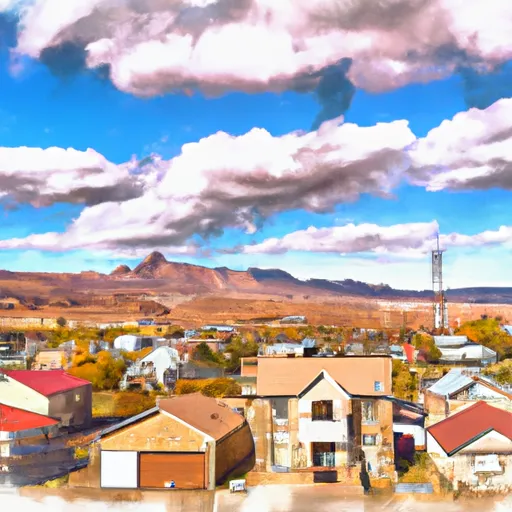-
 Snoflo Premium
Snoflo Premium
Get unlimited access to all our content
With no Ad interruptions! - Start Your Free Trial Login with existing account
Tridell
Eden Index
Climate
7.4
•
Recreation
1.4
•
Community
•
Safeguard
3.5/10

Tridell is a small town located in the Uintah Basin in northeastern Utah, United States. The town experiences a semi-arid climate, characterized by hot summers and cold winters. Summers bring average temperatures in the mid-80s°F (around 29°C), while winters can be quite chilly, with temperatures dropping below freezing. Precipitation is relatively low year-round, with most of it occurring during spring and early summer.
Hydrologically, Tridell is situated in an area with diverse water resources. The town relies on groundwater from wells for its water supply. The region is also dotted with small streams and rivers, which contribute to the local hydrology and provide opportunities for fishing and other water-based recreational activities.
Tridell and its surrounding areas offer various outdoor recreation opportunities. The nearby Ashley National Forest provides a picturesque backdrop for hiking, camping, and wildlife viewing. Outdoor enthusiasts can also enjoy hunting, ATV riding, and horseback riding in the vast expanses of public lands surrounding the town. Additionally, the Uintah and Ouray Indian Reservation, located near Tridell, offers cultural experiences, including powwows and traditional events, allowing visitors to immerse themselves in Native American heritage.
What is the Eden Index?
The Snoflo Eden Index serves as a comprehensive rating system for regions, evaluating their desirability through a holistic assessment of climate health, outdoor recreation opportunities, and natural disaster risk, acknowledging the profound impact of these factors on livability and well-being.
Climate Health Indicator (CHI): 7.4
Tridell receives approximately
232mm of rain per year,
with humidity levels near 69%
and air temperatures averaging around
8°C.
Tridell has a plant hardyness factor of
5, meaning
plants and agriculture in this region thrive during a short period during spring and early summer. Most
plants will die off during the colder winter months.
By considering the ideal temperature range, reliable water supplies, clean air, and stable seasonal rain or snowpacks, the Climate Health Indicator (CHI) underscores the significance of a healthy climate as the foundation for quality living.
A healthy climate is paramount for ensuring a high quality of life and livability in a region, fostering both physical well-being and environmental harmony. This can be characterized by ideal temperatures, reliable access to water supplies, clean air, and consistent seasonal rain or snowpacks.
Weather Forecast
Streamflow Conditions
Lower Green
Area Rivers
Lower Green
Snowpack Depths
Lower Green
Reservoir Storage Capacity
Lower Green
Groundwater Levels
Recreational Opportunity Index (ROI): 1.4
The Recreational Opportunity Index (ROI) recognizes the value of outdoor recreational options, such as parks, hiking trails, camping sites, and fishing spots, while acknowledging that climate plays a pivotal role in ensuring the comfort and consistency of these experiences.
Access to outdoor recreational opportunities, encompassing activities such as parks, hiking, camping, and fishing, is crucial for overall well-being, and the climate plays a pivotal role in enabling and enhancing these experiences, ensuring that individuals can engage in nature-based activities comfortably and consistently.
Camping Areas
| Campground | Campsites | Reservations | Toilets | Showers | Elevation |
|---|---|---|---|---|---|
| Sheep Creek Bay - Flaming Gorge | 16 | 6,050 ft | |||
| Red Springs | 14 | 10,483 ft | |||
| Pelican Lake | 12 | 4,815 ft |
Catastrophe Safeguard Index (CSI):
The Catastrophe Safeguard Index (CSI) recognizes that natural disaster risk, encompassing floods, fires, hurricanes, and tornadoes, can drastically affect safety and the overall appeal of an area.
The level of natural disaster risk in a region significantly affects safety and the overall livability, with climate change amplifying these risks by potentially increasing the frequency and intensity of events like floods, fires, hurricanes, and tornadoes, thereby posing substantial challenges to community resilience and well-being.
Community Resilience Indicator (CRI):
The Community Resilience Indicator (CRI) recognizes that education, healthcare, and socioeconomics are crucial to the well-being of a region. The CRI acknowledges the profound impact of these elements on residents' overall quality of life. By evaluating educational resources, healthcare accessibility, and economic inclusivity, the index captures the essential aspects that contribute to a thriving community, fostering resident satisfaction, equity, and social cohesion.

